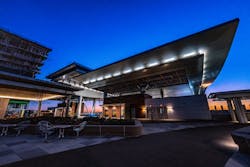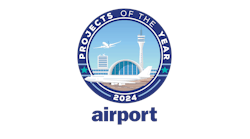Revolutionize Airport Development: The EPM Approach - Transforming North American Airports for the Future
North American airports are in the midst of their biggest capital improvement program since the creation of the air system. Stable FAA funding, additional funds from the Bipartisan Infrastructure Law and record demand for air travel are all fueling a need for modern airport infrastructure.
The Airport Business 2023 Infrastructure Survey shows 63% of airports are starting master planning within the next four years. Half of airports are investing funds today in architecture, engineering and planning purposes now to handle major capacity improvements in the next couple of years.
The Paslay Group is involved with managing some of the biggest airport improvement projects taking place today, offering a different approach than a lot of airports may be used to traditionally. CEO R. Clay Paslay discusses these efforts exclusively with Airport Business and how they can change the overall direction of the next major improvement you undertake.
Airport Business: Tell me about the current capital demand for airports in North America. Do you see this trend continuing?
R. Clay Paslay: I think it's going to continue for a while. There was a fair amount of pent up demand that was starting to accumulate pre-COVID and that put everything on the hold. Now just about every airport across the country has some degree of capital development underway or plan to be underway. A lot of airports are adding capacity. We're seeing a lot of airports gain a lot of new market share. Places like Austin and Nashville are growing unbelievably fast.
These programs take four or five years to complete, so I would venture to say for the next 10 years, we're going to see a pretty aggressive capital development marketplace at airports across country.
AB: One of the interesting things about your company is Executive Program Management (EPM) approach to capital projects. Can you explain how this is different from traditional program management?
CP: The executive program management model is something we created back in 2007. It was an outgrowth out of my experience at DFW where I was an executive responsible for capital development planning, design and construction.
Most airports may see a major capital development every 10 or 15 years, so they don't have the staff and the expertise to take on a major development. Historically, they'd go out and hire a project manager, who would come in, bring staff up and bring in your processes and systems. As an airport owner operator, you felt a little disassociated with your program.
If you look at the large program management companies, their business model is based on a volume kind of business structure. They'll man the job pretty heavily and as the owner you see a lot of staff, a lot of cost but are not really sure what the value added is.
EPM is just the top three or four positions. Your top executive program manager, your project controls manager, a construction manager, a design manager or another specialty depending on the airport's needs. It's just a small group that the owner contracts with to integrate with their executive team and become an extension of their organization that brings that experience and that knowledge to help them really think through the program, set up the strategy for the program, and what is the right delivery method, the financing approach, what are the appropriate project control systems we need based on what that particular airport's KPIs are.
The EPM model is limited just to the providing that leadership, that strategic leadership positions. They are prohibited then from providing any of the boots on the ground. From the owner's point of view it gets them an experienced, smaller team that they can get their arms around. It's also a more cost effective way to execute the program.
The owner works with the EPM to develop the overall program structure, the delivery method and project control systems you’re going to use.
AB: Adaptive execution is one of the key features you list for the EPM program. Can you give me an example of this?
CP: I like to use the word customization. It’s a more customized execution strategy to fit the owner's situation. The owner has objectives for the project. Maybe it's a cost control issue; maybe it's a speed to market issue for them or maybe it's a risk transfer. They also have inherent constraints. It may be political, it may be financial, may be cultural constraints, or may just be things they just don't do. Or it could be, you know, legal statutory constraints about how they can contract for stuff.
We look at their capabilities from a staffing standpoint, from a processing standpoint and then we customize execution strategy to fit their situation. We'll use that matrix to go through and evaluate different delivery models with them to see which delivery model best fits their situation. We'll take that, maybe even in customize that even a little bit more. As an example you could take design-build and make it look like a design-bid-build, but now you've transferred the risk. So there's, there's ways even within a delivery method model to customize it a little bit more to fit the owner.
That tells you what kind of KPIs you need to maintain, that informs your project control systems and it tells you which kind of contracting structure you're going to do, which is gonna drive your payment and procurement structure. With all that in place, you then can develop a communication strategy for the program that tells you what organizational structure you need to actually manage that.
AB: Tell us about how this program is being used at Nashville International Airport and how you’re using it to address challenges with completing this major project.
CP: When we started their big goal was to was speed to market. They were growing so fast, they needed to get gates open as quickly as they could. A lot of their development was right on top of their existing facilities, so there was a high degree of concern about the risk exposure. Cost control was another big issue for them, so that drove a delivery strategy that included using a master architect to direct the overall theme of the design.
We broke that up into multiple packages where we used a design-build delivery method in a multi-pack, fast track way. We got the gates open sooner than a more traditional approach to design-build. Once we went with a design-build delivery model, we transferred the risk to the design-build team.
AB: Major projects like Nashville can interfere with traffic inside and outside the terminal. What strategies have you used to make sure there aren’t challenges to traffic?
CP: We implemented a strategy that closed off the entire center core of the main terminal and basically created two separate terminals with two separate curbsides so the passenger impact was significantly minimized. We also incorporated a very aggressive communication strategy both in the local media and at airport, so the passenger knew what to expect when they got there. Then we did the normal stuff like limit certain construction activities to certain times of the day or night, depending on what the case may be. From a concession standpoint, you want to make sure you always have concessions available, even when, you know, you have the, a lot of the existing concessions shut down.
We try to minimize the impact to passengers as much as possible, but they will always be impacted in some way, so we make sure we have a comprehensive, proactive communication strategy so there's no surprises, they understand what's going on and to help ease the anxiety of that passenger trying to move through the airport and to the gate.
AB: Major projects like Pittsburgh and Nashville require a lot of different stakeholders to successfully pull these off. How does this management option you offer identify and bring in these key players?
CP: The best example is LAX. We employed a system we called construction and logistics management. We set up a network of regional leaders that received information on all kinds of airport impact operations, whether that was closing a lane, needing to shut down a fire sprinkler system, needing to take something electrical, offline, those kinds of things. We had daily kickoff meetings with representatives of operations and there was a monthly coordination meeting.
The other thing daily communication did where you have multiple projects going on at any one time, it created efficiencies. If we saw one contractor needed to shut down the sprinkler system on Tuesday, we had another contractor wanted to shut it down on Wednesday, we could coordinate with them and say shut it down once on Wednesday. Everybody gets their work done on Wednesday, and we'll only have it down for one evening.
AB: Utilizing this EPM strategy on both major airport improvement projects at large airports and even smaller regional airports, what types of projects or airports have the best success using this type of management model?
CP: It’s for an airport that isn’t continually doing several hundred million dollars per year in capital projects. Airports that haven’t done a major capital program in 10 or 15 years might not have that administrative infrastructure in place. They don’t have that skill set to take on a project of that magnitude.






